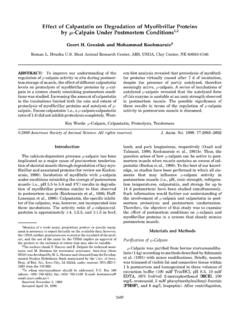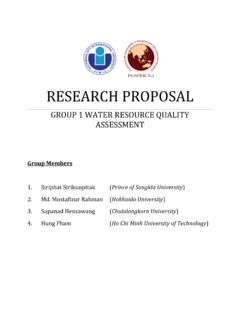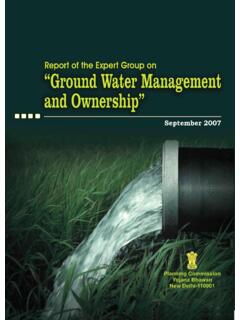Transcription of Tolerance of vegetable crops to salinity
1 Tolerance of vegetable crops to Shannon*, salinity Laboratory, Department of Agriculture, Agricultural Research Service,450 W. Big Springs Road, Riverside, CA 92507, USAA bstractGlobal constraints on fresh water supplies and the need to dispose of agricultural, municipal, andindustrial waste waters have intensified interest in water reuse options. In many instances, the valueof the water is decreased solely because of its higher salt concentration. Although quantitativeinformation on crop salt Tolerance exists for over 130 crop species, there are many vegetables whichlack definitive data. vegetable crops are defined as herbaceous species grown for humanconsumption in which the edible portions consist of leaves, roots, hypocotyls, stems, petioles, andflower buds.
2 The salt Tolerance of vegetable species is important because the cash value ofvegetables is usually high compared to field crops . In this review some general information ispresented on how salinity affects plant growth and development and how different measurements ofsalinity in solution cultures, sand cultures, and field studies can be reconciled to a common salt Tolerance of vegetables has been condensed and reported in a uniform format based on thebest available data. Discrepancies and inconsistencies exist in some of the information due todifferences in cultivars, environments, and experimental conditions. For a great number of specieslittle or no useful information exists and there is an obvious need for research.
3 Published by ElsevierScience : Salt Tolerance ; Ion compositionContents1. General Soil salinity measurement .. salinity Definition of salt Other salt Tolerance Tolerance to specific ions .. Reconciliation of data ..13 Scientia Horticulturae 78 (1999) 5 38* Corresponding $ see front matter Published by Elsevier Science : S0304-4238(98)00189-72. Amaryllidaceae (leek, onion, garlic, chive).. Onion (Allium cepa L.).. Garlic (Allium sativum L.).. Liliaceae.. Apiaceae (carrot, celery, coriander, fennel, parsnip, parsley).. Carrot (Daucus carota L.).. Celery (Apium graveolens L. var. dulce (Mill.) Pers.).. Fennel (Foeniculum vulgare Mill.).. Parsnip (Pastinaca sativa L.).
4 Minor umbelliferous Araceae (taro).. Taro (Colocasia esculenta (L.) Schott).. Asteraceae (lettuce, endive, artichoke, Jerusalem artichoke, radicchio).. Lettuce (Latuca sativa, L.).. Jerusalem artichoke (Helianthus tuberosus).. Globe artichoke (Cynara scolymus).. Brassicaceae (cabbage, broccoli, cauliflower, mustards, radish, kale) .. Kale (B. oleraceae, Acephala group).. Broccoli (B. oleracea, Botrytis group).. Cauliflower (B. oleracea, Botrytis group).. Cabbage (B. oleracea, Capitata group).. Brussels sprout (B. oleraceae, Gemmifera group).. Kohlrabi (B. oleracea, Gongylodes group).. Chinese cabbage (B. campestris, Pekinensis group).. Pak choi (B. rapa, Chinensis group).
5 Mustard greens (B. juncea (L.) Czern. and Coss.).. Turnip (B. rapa L. Rapifera group).. Arugula, Taramira, Rocket (Eruca sativa Mill.).. Radish (Raphanus sativus L.) .. Spinach (Spinacia oleracea L.) .. Swiss chard (Beta vulgaris (L.) Koch, Cicla group).. Table beet (B. vulgaris L.).. Garden Orach (Atriplex hortensis L.).. Convolvulaceae (sweet potato).. Sweet potato (Ipomoea batatas (L.) Lam.).. Cassava, `Manioc', `Brazilian arrowroot' (Manihot esculenta Crantz).. Portulaceae .. Purslane (Portulaca oleraceae L.) .. Solanaceae (potato).. Potato (Solanum tuberosum L.) ..304. Shannon, Grieve / Scientia Horticulturae 78 (1999) 5 381. General commentsThe intent of this review is to summarize current knowledge concerning the salttolerance of vegetable crops .
6 We have opted to define vegetables in a strict senseas those herbaceous species grown for human consumption in which the edibleportions consist of leaves (lettuce, cabbage), swollen tap roots, ( carrot),lateral roots (sweet potato), hypocotyls (radish, turnip), aboveground stems(asparagus), below ground stems (Irish potato, Jerusalem artichoke), petioles(celery), and flower buds (globe artichoke, cauliflower). We specifically excludetomato, despite the fact that it was ordained as a vegetable by an act of theCongress of the United States in 1897. This review will not cover in detail thebiochemical or molecular aspects of the responses of vegetable crops to salinity ;but rather, general Tolerance to salt and ions that are commonly associated withsaline soils and waters.
7 For many species we have found that the quantitativeinformation on salt Tolerance is meager; sometimes it is completely salt Tolerance data come from well-replicated studies conducted over anadequate range of salinities. Such studies should report data on environmentalconditions, cultural practices, and especially those data related to water andsalinity status of the root zone. Only a small proportion of salinity studies consistof enough critical information to satisfy the requirements of a good salt tolerancedata Soil salinity measurementUsually, salinity is measured in units of electrical conductivity of a saturatedsoil paste extract (ECe) taken from the root zone of the plant and averaged overtime and depth.
8 Soil paste extracts are soil samples that are brought up to theirwater saturation points (USDA, 1954). Electrical conductivities are measured onthe vacuum-extracted and filtered water extracts from these samples in units ofdeciSiemens per meter (dS m 1), or previously as millimhos per centimeter(mmho cm 1). The advantage of using saturation extracts as a method ofmeasuring and referencing salinity is that this measurement is directly related tothe field moisture range for most soils (USDA, 1954). The soluble saltconcentration in a saturation extract is roughly one half as concentrated as the soilwater at saturation for a wide range of soil textures from medium to fine. Thus, ameasured ECeof 4 dS m 1would be equivalent to an EC of about 8 dS m 1inthe soil water of a medium-textured soil at field capacity.
9 For coarse, sandy soils,soil water EC would be higher (approaching 12 dS m 1). Soil to water extracts of1:1 or 1:5 can be more easily made and measured than saturation extracts andback calculations can be developed to ECefor a given soil. New methods Shannon, Grieve / Scientia Horticulturae 78 (1999) 5 387electronic probes or electromagnetic pulses to calculate ECewith even less timeand effort (Rhoades, 1976, 1993). salinity effectsThe general effect of salinity is to reduce the growth rate resulting in smallerleaves, shorter stature, and sometimes fewer leaves. The initial and primary effectof salinity , especially at low to moderate concentrations, is due to its osmoticeffects (Munns and Termaat, 1986; Jacoby, 1994).
10 Roots are also reduced inlength and mass but may become thinner or thicker. Maturity rate may be delayedor advanced depending on species. The degree to which growth is reduced bysalinity differs greatly with species and to a lesser extent with varieties within aspecies. The severity of salinity response is also mediated by environmentalinteractions such as relative humidity, temperature, radiation and air pollution(Shannon et al., 1994). Depending upon the composition of the saline solution,ion toxicities or nutritional deficiencies may arise because of a predominance of aspecific ion or competition effects among cations or anions (Bernstein et al.,1974). The osmotic effects of salinity contribute to reduced growth rate, changesin leaf color, and developmental characteristics such as root/shoot ratio andmaturity rate.













